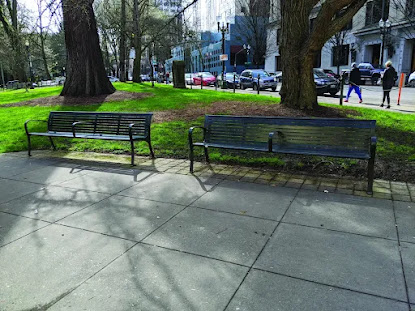Hostile architecture in downtown Portland
I moved to the park blocks in downtown Portland in September of 2019, in preparation for attending my first term at Portland State. I was only able to spend about six months in the city before COVID hit, forcing us into virtual environments and forcing me to move back home, but I explored the city plenty before then. Coming from Los Angeles, California, I am no stranger to alarmingly large homeless populations, especially in city centers. I am also no stranger to the use of hostile architecture for the purpose of barring the homeless from certain public spaces. However, downtown Portland really blew me away with its excessive commitment to implementing hostile architecture wherever physically possible. This is easily visually observable when roaming the city streets, but the weight of the situation grows when researching just how much money the city dedicates to blocking access to spaces for the homeless.
Hostile architecture can come in many forms, from a simple bar or metal arm rest built into the center of a bench where homeless might choose to lie down, to seas of concrete spikes layed out underneath bridges that the city wants to ban the homeless from using as a source of shelter. Regardless of its appearance, it is an intentional design strategy used to make it next to impossible for homeless individuals to rest on certain surfaces, often justified by the city by framing these unnecessary architectural adjustments as artistic or aesthetic choices. Just last year, the city of Portland put forth a $500,000 movement to build a handful of extra benches along places in Laurelhurst Park commonly used by homeless people to rest; there were no funding considerations for relocation of the individuals that were moved out of these spaces during pre-construction sweeps of the park. In fact, many of the homeless removed during these sweeps returned to their familiar spots in Laurelhurst Park even after the benches were implemented, making the $500,000 spent by the city virtually pointless as the bench placement did not deter the populations the city so desperately wanted to displace, remove, and ultimately erase from the area.
While the implementation of hostile architecture is typically facilitated by city officials, it is also commonly utilized by citizens. In January of 2019, a downtown Portland 7-11 store was reported for using an illegal piercing siren to displace homeless individuals that had the tendency to rest or sleep near the store. Local homeless individuals reported the blaring sound continuing for multiple days and throughout the night, a sound that would drive any citizen insane, but especially one with no escape from the streets where the sound is the loudest. Those with sensitive hearing reported their inability to rest or sleep. The implications of this blaring high-pitched noise affecting homeless individuals with more fragile mental health states are scary to think about. The clerk of this 7-11 located on Southwest 4th and Taylor confirmed that the alarm was a purposeful attempt to disperse the homeless population that spent their time around the store, in order to create a safer environment for customers and employees. The environment is not made safer when all the alarm achieves is the violent effects on homeless individuals’ mental states. The environment is not made more enjoyable or accessible for housed citizens either, when they have to endure the same screeching alarm if shopping there. This implementation feels almost more violent than some forms of hostile architecture, since its entire purpose is to drive listeners so insane that they cannot endure the noise any longer. Thankfully, the siren was recognized as being at a volume of twice the legal limit and hasn’t been used since.
All in all, the implementation of various forms of hostile architecture is an ineffective process for the purposes of its utilization by city officials. Despite its inefficacy, it is still regularly utilized as a means of making homeless existence and, more specifically, homeless rest and relaxation, harder than it already is to endure or achieve. Is this continued utilization really for the purposes of displacing homeless individuals, which city officials (especially in Portland) have watched it fail to do again and again? I believe this is more of an issue of disparaging social understandings of homeless populations resulting in poor perceptions of what homeless individuals ‘deserve,’ and the reality that city officials get to decide what that awarding or rescinding of privilege looks like.
https://www.streetroots.org/news/2021/12/08/hostile-architecture
https://fhspost.com/hostile-architecture/
https://theath.ca/arts-culture/dark-art-anti-homeless-architecture/
by Sierra Still





Comments
Post a Comment